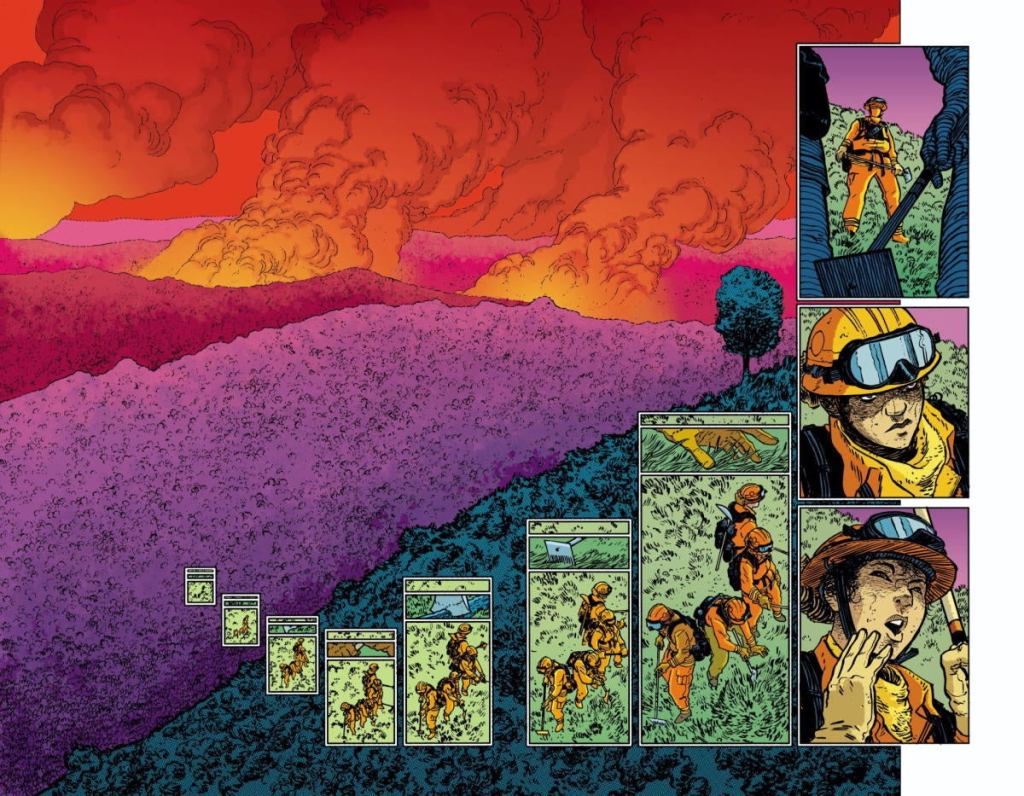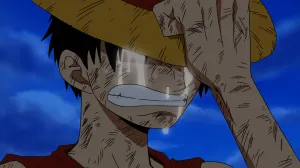Dark Spaces: Wildfire #1 presents a world on fire, its intricate renderings comprised of short, curved linework and slightly psychedelic, neon-infused colors creating the sense that one is viewing events through a heat haze. For the five women fighting the blaze tearing through California, the lives they once knew burnt up a long time ago. Four of them are prisoners making a pittance by risking their lives to help put out wildfires. The fifth is their supervising correctional officer, using “the line” as a refuge from her personal inferno as much as those under her watch are taking the opportunity to get out of their cells. At the heart of it is the question of whether any of them can escape the flaming circles they’ve been trapped in or if they’re all doomed to the fiery death foreshadowed in the issue’s opening pages.
Videos by ComicBook.com
Dark Spaces: Wildfire, the inaugural IDW Originals release, hails from writer Scott Snyder, a veteran of the “HBO of comics” era of DC’s now defunct Vertigo imprint, teaming with artist Hayden Sherman and colorist Ronda Pattison. Having Snyder’s name on the masthead of the debut outing is a strong play for the new label to attract the eyes of anyone still looking for “the next Vertigo,” and the basic premise of the issue isn’t far afield from what late-era Vertigo published. It’s a heist story where a prisoner-firefighter brigade decides to try to beat the blaze to a house hiding enough riches to give them all a fresh start.

The issue efficiently attaches readers to these characters. Their personalities, running from stoic to giddy, come across quickly through both Snyder’s writing and Sherman’s knack for body language. The irony of the scene in which the women chew on candy cigarettes while surrounded by billowing smoke is particularly charming.
It achieves this without offering any solid backstory on the characters, which isn’t a concession, but rather the point. Ma, the supervising officer who narrates the story, insists that everyone’s life starts anew on the line. She knows the reader wants to know what these women did to wind up here but refuses to divulge that information. None of it matters now, she insists, and the slow erosion of that fundamental lie in Ma’s mind is what sets the stage for everything to come.
As Ma explains, there are four official stages to a wildfire, but she sees an unofficial fifth, which she calls “the trap.” The trap is all the things that set the stage for the blaze to start, that period of time before the fire sparks when something could be done to prevent it from ever happening.
Ma expands that reasoning to apply to all manner of other circumstances, personal and global, some more subtly than others. As the beetle infestation and drought set the stage for wildfires, mankind’s decades of inaction regarding climate change was the trap that set the stage for wildfires growing from a seasonal hazard to a year-round danger. For Ma, her decades spent fighting these fires is likely the trap that allowed for the deadly four-stage hazard growing in her body to take root. And, as much as Ma chooses not to think about it at first, the carceral system stacked against the vulnerable is the trap that brought these women to where they are, risking their lives for a nominal fee while protecting the private property of those who routinely contribute and benefit from that system. It’s the same trap that will likely keep them there, or bring them back, until the day they die.
It may seem obvious to key into the “Wildfire” portion of the title visually, but it makes sense, especially when pulled off this well. Pattison’s colors permeate each page, the purples, reds, and oranges setting the mood, tone, and aesthetic, and becoming more intense as the stakes rise. The fiery palette is slightly otherworldly and she deploys blues with precision, breaking things up and drawing focus. The real world, this existence being engulfed in flames, contrasts against the characters’ daydreams of better lives with their more peaceful pastel palette, solid but fragile like reflections on the top of a lake.
Sherman keys in on the cross-section of causality and scale in the issue’s themes, using his layouts to express the characters’ relationships to time and the world around them. One stunning spread sets a sequence of panels repeating endlessly until they blur together into a great white nothingness as a backdrop for a smaller set of panels (smartly offset by contrasting colors) in the foreground depicting a single action—throwing a stuffed animal—as a complete summation of the emotional throughline of this person’s life. It’s a bold swing that aims for the heart and does not miss.
In addition to time and memory, Sherman’s layouts also play with space, contrasting the enormity of the forest and the blaze consuming it against the smallness of the characters with thoughtful compositions and panel positioning. He applies one creative layout after another, ensuring turning the issue’s pages never stops being exciting. His ability to draw believable characters that express their personality subtly but distinctly allows readers to become invested despite not knowing much about the cast’s history. His linework gives each character texture as if they themselves could catch fire at any moment.
AndWorld Designs’ lettering applies a similar sense of texture and thematic immersion. The orange tint of the captions appears as if the words themselves heating up, while the stark scratched lettering in the “KAFF KAFF” effect of Ma’s hacking cough is appropriately obtrusive, shaking readers and characters from the reverie of the previous page.
Dark Spaces: Wildfire #1 is an eye-catching and evocative debut. The issue cements Sherman and Pattison as two artistic talents to watch while Snyder provides the high level of craft fans have come to expect of him. While Snyder’s plotting is as strong as ever, it’s the subtext that elevates Dark Spaces: Wildfire #1 to the next level. Readers will be instantly immersed and eager to see what comes next.
Published by IDW Publishing
On July 20, 2022
Written by Scott Snyder
Art by Hayden Sherman
Colors by Ronda Pattison
Letters by AndWorld Design
Cover by Hayden Sherman








